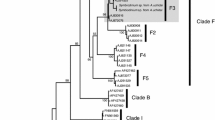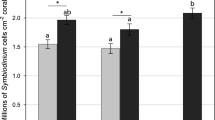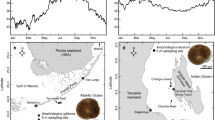Abstract
Despite the ecological importance of anemonefish symbioses, little is known about how nutritional contributions from anemonefish interact with sea anemone physiology and Symbiodinium (endosymbiotic dinoflagellate) genetic identity under field conditions. On Red Sea coral reefs, we measured variation in ammonia concentrations near anemones, excretion rates of anemonefish, physiological parameters of anemones and Symbiodinium, and genetic identity of Symbiodinium within anemones. Ammonia concentrations among anemone tentacles were up to 49% above background levels, and anemonefish excreted ammonia significantly more rapidly after diurnal feeding than they did after nocturnal rest, similar to their excretion patterns under laboratory conditions. Levels of 4 physiological parameters (anemone protein content, and Symbiodinium abundance, chlorophyll a concentration, and division rate) were similar to those known for laboratory-cultured anemones, and in the field did not depend on the number of anemonefish per anemone or depth below sea surface. Symbiodinium abundance varied significantly with irradiance in the shaded reef microhabitats occupied by anemones. Most anemones at all depths harbored a novel Symbiodinium 18S rDNA variant within internal transcribed spacer region 2 (ITS2) type C1, while the rest hosted known ITS2 type C1. Association with Symbiodinium Clade C is consistent with the symbiotic pattern of these anemones on other Indo-Pacific reefs, but the C1 variant of Symbiodinium identified here has not been described previously. We conclude that in the field, anemonefish excrete ammonia at rapid rates that correlate with elevated concentrations among host anemone tentacles. Limited natural variation in anemonefish abundance may contribute to consistently high levels of physiological parameters in both anemones and Symbiodinium, in contrast to laboratory manipulations where removal of fish causes anemones to shrink and Symbiodinium to become less abundant.





Similar content being viewed by others
References
Achituv Y, Mizrahi L (1996) Recycling of ammonium within a hydrocoral (Millepora dichotoma)-zooxanthellae-cirripede (Savignium milleporum) symbiotic association. Bull Mar Sci 58:856–860
Baker AC (2003) Flexibility and specificity in coral-algal symbiosis: diversity, ecology and biogeography of Symbiodinium. Ann Rev Ecol Evol Syst 34:661–689
Barneah O, Weis VM, Perez S, Benayahu Y (2004) Diversity of dinoflagellate symbionts in Red Sea soft corals: mode of symbiont acquisition matters. Mar Ecol Prog Ser 275:89–95
Berkelmans R, van Oppen JH (2006) The role of zooxanthellae in the thermal tolerance of corals: a ‘nugget of hope’ for coral reefs in an era of climate change. Proc R Soc Lond B 273:2305–2312
Bluthgen N, Menzel F, Hovestadt T (2007) Specialization, constraints, and conflicting interests in mutualistic networks. Curr Biol 17:341–346
Buddemeier RW, Fautin DG (1993) Coral bleaching as an adaptive mechanism. Bioscience 43:320–326
Chadwick NE, Arvedlund M (2005) Abundance of giant sea anemones and patterns of association with anemonefish in the northen Red Sea. J Mar Biol Assoc UK 85:1287–1292
Chadwick NE, Ďuriš Z, Horká I (2008) Biodiversity and behavior of shrimps and fishes symbiotic with sea anemones in the Gulf of Aqaba, northern Red Sea. In: Por FD (ed) Aqaba-Eilat, The improbable gulf: environment, biodiversity, and preservation. Magnes Press, Hebrew University, Jerusalem, pp 209–223
Cleveland A, Verde EA, Lee RW (2010) Nutritional exchange in a tropical tripartite symbiosis. Mar Biol. doi:10.1007/s00227-010-1583-5
Coffroth MA, Santos SR (2005) Genetic diversity of symbiotic dinoflagellates in the genus Symbiodinium. Protist 156:19–34
Coffroth MA, Lasker HR, Diamond ME, Bruenn JA, Bermingham E (1992) DNA fingerprints of a gorgonian coral: a method for detecting clonal structure in a vegetative species. Mar Biol 114:317–325
Fabricius KE, Mieog JC, Colin PL, Idip D, van Oppen MJH (2004) Identity and diversity of coral endosymbionts (zooxanthellae) from three Palauan reefs with contrasting bleaching, temperature and shading histories. Mol Ecol 13:2445–2458
Falkowski PG, Jokiel PL, Kinzie RA (1990) Irradiance and corals. In: Dubinsky Z (ed) Coral Reefs, Ecosystems of the World. Elsevier Science Publishers, Amsterdam, pp 89–107
Fautin DG, Allen GR (1997) Anemone fishes and their host sea anemones, Revisedth edn. Western Australian Museum, Perth, p 160
Fukatsu T (1999) Acetone preservation: a practical technique for molecular analysis. Mol Ecol 8:1935–1945
Godinot C, Chadwick NE (2009) Phosphate excretion by anemonefish and uptake by giant sea anemones: demand outstrips supply. Bull Mar Sci 85:1–9
Godwin J, Fautin DG (1992) Defense of host actinians by anemonefishes. Copeia 3:902–907
Holbrook SJ, Schmitt RJ (1997) Settlement patterns and process in a coral damselfish: In situ nocturnal observations using infared video. Proc 8th Int Coral Reef Symp 2:1143–1148
Holbrook SJ, Schmitt RJ (2004) Population dynamics of a damselfish: effects of a competitor that also is an indirect mutualist. Ecology 85:979–985
Holbrook SJ, Schmitt RJ (2005) Growth, reproduction and survival of a tropical sea anemone (Actiniaria): benefits of hosting anemonefish. Coral Reefs 24:67–73
Karako-Lampert S, Katcoff DJ, Achituv Y, Dubinsky Z, Stambler N (2004) Do clades of symbiotic dinoflagellates in scleractinian corals of the Gulf of Eilat (Red Sea) differ from those of other coral reefs? J Exp Mar Biol Ecol 311:301–314
Knowlton N, Rohwer F (2003) Multispecies microbial mutualisms on coral reefs: the host as a habitat. Am Nat 162:S51–S62
Kuguru B, Winters G, Beer S, Santos SR, Chadwick NE (2007) Adaptation strategies of the corallimorpharian Rhodactis rhodostoma to irradiance and temperature. Mar Biol 151:1287–1298
Kuguru B, Chadwick NE, Achituv Y, Zendbank K, Tchernov D (2008) Mechanisms of habitat segregation between corallimorpharians: photosynthetic parameters and Symbiodinium types. Mar Ecol Prog Ser 369:115–129
LaJeunesse TC (2001) Investigating the biodiversity, ecology, and phylogeny of endosymbiotic dinoflagellates in the genus Symbiodinium using the ITS region: in search of a “species” level marker. J Phycol 37:866–880
LaJeunesse TC (2002) Diversity and community structure of symbiotic dinoflagellates from Caribbean coral reefs. Mar Biol 141:387–400
LaJeunesse TC, Trench RK (2000) Biogeography of two species of Symbiodinium (Freudenthal) inhabiting the intertidal sea anemone Anthopleura elegantissima (Brandt). Biol Bull 199:126–134
LaJeunesse TC, Loh WK, van Woesik R, Hoegh-Guldberg O, Schmidt GW, Fitt WK (2003) Low symbiont diversity in southern Great Barrier Reef corals, relative to those of the Caribbean. Limnol Oceanogr 48:2046–2054
Lampert-Karako S, Stambler N, Katcoff DJ (2008) Effects of depth and eutrophication on the zooxanthella clades of Stylophora pistillata from the Gulf of Eilat (Red Sea). Aquat Conserv Mar Freshw Ecosyst 18:1039–1045
Liberman T, Genin A, Loya Y (1995) Effects on growth and reproduction of the coral Stylophora pistillata by the mutualistic damselfish Dascyllus marginatus. Mar Biol 121:741–746
Loya Y, Lubinsevsky H, Rosenfeld M, Kramarsky-Winter E (2004) Nutrient enrichment caused by in situ fish farms at Eilat, Red Sea is detrimental to coral reproduction. Mar Pollut Bull 49:344–353
Maroz A, Fishelson L (1997) Juvenile production of Amphiprion bicinctus (Pomacentridae, Teleostei) and rehabilitation of impoverished habitats. Mar Ecol Prog Ser 151:295–297
Meyer JL, Schultz ET (1985) Migrating haemulid fishes as a source of nutrients and organic matter on coral reefs. Limnol Oceanogr 30:146–156
Miller DJ, Yellowlees D (1989) Inorganic nitrogen uptake by symbiotic marine cnidarians: a critical review. Proc R Soc Lond B 237:109–125
Mokady O, Loya Y, Lazar B (1998) Ammonium contribution from boring bivalves to their coral host—a mutualistic symbiosis? Mar Ecol Prog Ser 169:295–301
Muller-Parker G, Davy SK (2001) Temperate and tropical algal-sea anemone symbioses. Inver Biol 120:104–123
Patzner RA (2004) Associations with sea anemones in the Mediterranean Sea: a review. Ophelia 58:1–11
Pinnegar JK, Polunin NVC (2006) Planktivorous damselfish supports significant nitrogen and phosphorus fluxes to Mediterranean reefs. Mar Biol 148:1089–1099
Pochon X, Montoya-Burgos JI, Stadelmann B, Pawlowski J (2006) Molecular phylogeny, evolutionary rates, and divergence timing of the symbiotic dinoflagellate genus Symbiodinium. Mol Phylogenet Evol 38:20–30
Polunin NVC, Koike I (1987) Temporal focusing of nitrogen release by a periodically feeding herbivorous reef fish. J Exp Mar Biol Ecol 111:285–296
Porat D, Chadwick-Furman NE (2004) Effects of anemonefish on giant sea anemones: Expansion behavior, growth and survival. Hydrobiologia 530/531:513–520
Porat D, Chadwick-Furman NE (2005) Effects of anemonefish on giant sea anemones: Ammonium uptake, zooxanthella content and tissue regeneration. Mar Freshw Behav Physiol 38:43–51
Randall JE, Fautin DG (2002) Fishes other than anemonefishes that associate with sea anemones. Coral Reefs 21:188–190
Reynolds JM, Bruns BU, Fitt WK (2008) Enhanced photoprotection pathways in symbiotic dinoflagellates of shallow-water corals and other cnidarians. Proc Nat Acad Sci USA 105:13674–13678
Rohwer F, Seguritan V, Azam F (2002) Diversity and distribution of coral-associated bacteria. Mar Ecol Prog Ser 243:1–10
Roopin M, Chadwick NE (2009) Benefits to host sea anemones from ammonia contributions of resident anemonefish. J Exp Mar Biol Ecol 370:27–34
Roopin M, Henry RP, Chadwick NE (2008) Nutrient transfer in a marine mutualism: patterns of ammonia excretion by anemonefish and uptake by giant sea anemones. Mar Biol 154:547–556
Rowan R (2004) Thermal adaptation in reef coral symbionts. Nature 430:742
Rowan R, Powers DA (1991a) A molecular genetic identification of zooxanthellae and the evolution of animal-algal symbioses. Science 251:1348–1351
Rowan R, Powers DA (1991b) Molecular genetic identification of symbiotic dinoflagellates (zooxanthellae). Mar Ecol Prog Ser 71:65–73
Rüppell E, Leuckart FS (1828) NeuewirbelloseThiere des RothenMeeres. In: Rüppell E (ed) Atlas zuder Reiseimnördlichen Afrika Erste Abtheilung Zoologie. Brunner, Frankfurt am Main, pp 1–22
Sampayo EM, Dove S, LaJeunesse TC (2009) Cohesive molecular genetic data deliniate species diversity in the dinoflagellate genus Symbiodinium. Mol Ecol 18:500–519
Santos SR, Taylor DJ, Kinzie RA, Hidaka M, Sakai K, Coffroth MA (2002) Molecular phylogeny of symbiotic dinoflagellates inferred from partial chloroplast large subunit (23S)-rDNA sequences. Mol Phylogenet Evol 23:97–111
Santos SR, Kinzie RA III, Sakai K, Coffroth MA (2003) Molecular characterization of nuclear small subunit (18S)-rDNA pseudogenes in a symbiotic dinoflagellate (Symbiodinium, Dinophyta). J Eukaryot Microbiol 50:417–421
Scott A, Harrison PL (2007) Embryonic and larval development of the host sea anemones Entacmaea quadricolor and Heteractis crispa. Biol Bull 213:110–121
Solorzano L (1969) Determination of ammonium in natural waters by the phenol hypochlorite method. Limnol Oceanogr 14:799–801
Spotte S (1996) Supply of regenerated nitrogen to sea anemones by their symbiotic shrimp. J Exp Mar Biol Ecol 198:27–36
Stachowicz JJ (2001) Mutualism, facilitation, and the structure of ecological communities. Bioscience 51:235–246
Stambler N, Levy O, Vaki L (2008) Photosynthesis and respiration of hermatypic zooxanthellate Red Sea corals from 5–7 m depth. Israeli J Plant Sci 56:45–53
Taylor DL (1974) Symbiotic marine algae: taxonomy and biological fitness. In: Vernberg WB (ed) Symbiosis in the Sea. University of South Carolina Press, Columbia, pp 245–262
Tchernov D, Gorbunov MY, de Vargas C, Yadav SN, Milligan AJ, Häggblom M, Falkowski PG (2004) Membrane lipids of symbiotic algae are diagnostic of sensitivity to thermal bleaching in corals. Proc Nat Acad Sci USA 101:13531–13535
Thornhill DJ, LaJeunesse TC, Kemp DW, Fitt WK, Schmidt GW (2006a) Multi-year, seasonal genotypic surveys of coral-algal symbioses reveal prevalent stability or post-bleaching reversion. Mar Biol 148:711–722
Thornhill DJ, Fitt WK, Schmidt GW (2006b) Highly stable symbioses among western Atlantic brooding corals. Coral Reefs 25:515–519
Titlyanov EA, Shaposhnikova MG, Zvalinskii VI (1980) Photosynthesis and adaptation of corals to irradiance. 1. Contents and native state of photosynthetic pigments in symbiotic microalgae. Photosynthetica 14:413–421
Toller WW, Rowan R, Knowlton N (2001) Zooxanthellae of the Montastraea annularis species complex: patterns of distribution of four taxa of Symbiodinium on different reefs and across depths. Biol Bull 201:348–359
Ulstrup KE, van Oppen MJH (2003) Geographic and habitat partitioning of genetically distinct zooxanthellae (Symbiodinium) in Acropora corals on the Great Barrier Reef. Mol Ecol 12:3477–3484
Venn AA, Loram JE, Douglas AE (2008) Photosynthetic symbioses in animals. J Exp Bot 59:1069–1080
Warner ME, Fitt WK, Schmidt GW (1999) Damage to photosystem II in symbiotic dinoflagellates: A determinant of coral bleaching. Proc Nat Acad Sci USA 96:8007–8012
Winters G, Loya Y, Rottgers R, Beer S (2003) Photoinhibition in shallow-water colonies of the coral Stylophora pistillata as measured in situ. Limnol Oceanogr 48:1388–1393
Zhang Z, Green BR, Cavalier-Smith T (2000) Phylogeny of ultrarapidly evolving dinoflagellate chloroplast genes: a possible common origin for sporozoan and dinoflagellate plastids. J Mol Evol 51:26–41
Acknowledgements
We thank Baraka Kuguru for field assistance, and Mark Liles, Dusty Kemp, and Greg Schmidt for assistance with DGGE analysis. Joseph Szczebak created the artwork for Fig. 1. Funding was provided by start-up funds to NEC and a graduate research award to MR, both from Auburn University. This research is submitted in partial fulfillment of the requirements for a M.Sc. degree to MR at Auburn University. All sampling for this study complies with the current laws of Israel. This is contribution #51 of the Auburn University Marine Biology Program.
Author information
Authors and Affiliations
Corresponding author
Rights and permissions
About this article
Cite this article
Roopin, M., Thornhill, D.J., Santos, S.R. et al. Ammonia flux, physiological parameters, and Symbiodinium diversity in the anemonefish symbiosis on Red Sea coral reefs. Symbiosis 53, 63–74 (2011). https://doi.org/10.1007/s13199-011-0110-x
Received:
Accepted:
Published:
Issue Date:
DOI: https://doi.org/10.1007/s13199-011-0110-x




